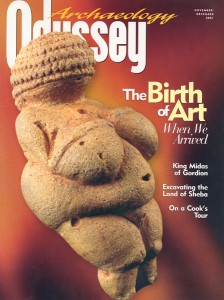Excavating the Earliest Humans
Sidebar to: When We Arrived
In prehistoric times, the Dead Sea Rift—a segment of the Great African Rift—functioned as a kind of migratory superhighway for early and modern hominids as they left Africa and headed for new territories in temperate Eurasia.
I have excavated at three sites from the Lower and Middle Paleolithic periods (1.4 million to 44,000 years ago) along this “Levantine Corridor.” Our excavations have revealed that even very early hominids were sophisticated tool-makers and creative thinkers.
At each of the sites—Gesher Benot Ya’aqov, near the Jordan River, which was occupied from 780,000 B.P.; Berekhat Ram, in the Golan Heights, which dates to about 233,000 B.P.; and Biquat Quneitra, also in the Golan Heights, which dates to 54,000 B.P.—we found impressive evidence of organized tool assembly. Large basalt blocks had been transported to Gesher Benot Ya’aqov and formed into hand axes and cleavers. We’ve also uncovered nonutilitarian artifacts of unprecedented antiquity that were modified and shaped by human hands. These finds were recovered in association with thousands of stone artifacts (at all three sites) and bones (at Gesher Benot Ya’aqov and Biquat Quneitra), as well as wood, fruit and seed remains (at Gesher Benot Ya’aqov).
Already a library member? Log in here.
Institution user? Log in with your IP address.

